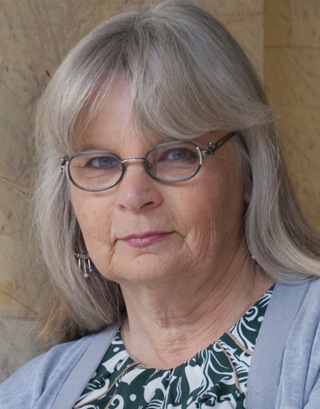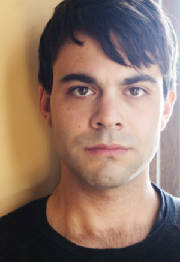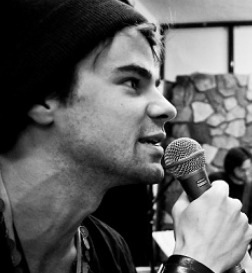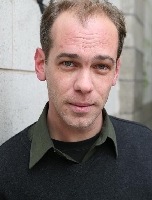Satyrs in L.A.
The Trackers by Sophocles: The Making of a Satyr Play
directed by Michael Hackett, Chair of the
Department of Theater at UCLA
Satyr Atlas
a work in progress by
Poor Dog Group
Cyclops: A Rock Opera from Euripides
Percy Bysshe Shelley translation
by
Psittacus Productions
Interviews by Mary Hart
Getty Museum
 Mary Hart |
 John Kerns |
 Michael Hackett |
 Jesse Bonnell |
 Chas Libretto |
 Louis Butelli |
 Poor Dog Group Satyr Chorus | ||
Cyclops: A Rock Opera Trailer | ||
In the fall of 2010 I curated “The Art of Ancient Greek Theater” at the Getty Villa in Malibu, California, a major international loan exhibition that assembled most of the finest extant objects depicting and reflecting theater from ancient Greece. A major theme of the exhibition was to explore the many ways Greek plays and stagecraft inspired classical artists, whose works are often the only surviving evidence of the birth and early development of this potent art form. In turn, the displayed depictions of actors, chorus men, satyrs, gods and plays—as well as a rare papyrus of Sophocles’ Ichneutai from the British Library—themselves became the catalyst for performance, inspiring three contemporary versions of satyr plays. Taken together, these productions represent an exceptionally concentrated approach to the performance of that nearly lost art form.
During the run of the exhibition, an international symposium entitled “Artists and Actors: Iconography and Performance in Ancient Greece” investigated the relationship between art and performance in ancient Greece. The idea of producing a satyr play for our own Villa Theater Lab series inspired a “Satyr” lunch, held during the Symposium to provide an opportunity for speakers and invited guests—directors and actors—to share their experiences and observations. We noted with some surprise that while fragments of satyr plays and Euripides’ Cyclops had been sporadically produced in academic settings, no one present had first-hand experience with a professional production. Tony Harrison’s Trackers of Oxyrhyncus, presented by the poet at Delphi in 1988 and at the National Theater, London, in 1990, was naturally evoked as the contemporary masterwork of the genre.
At the lunch John Kerns, a member of Poor Dog Group, answered the call for a working definition of a satyr. As he recalls:
Satyr territory is ‘the eternal’ and yet they are not immortal. They are also not human. They are part of a primitive inhumanity; leftover from the time before man—a time of gods—they exist as a residue produced in providence by those most comprehensive beings. Their faculties are godlike, born of Dionysian gratuity. They possess a total vision: every particularity of the world and the sum total of time are the ineradicable inhabitants of their memory. As a result, they are incapable of general, platonic ideas so they appear to us as disinterested, remote and godforsaken. The Satyrs are the face and knowledge of the gods cast in outrageous, semi-human representation. Herein lies their humor: they perceive with the capacity of gods as they stumble about in horse/human soma. Their dance is an irreconcilable confrontation with chaos, one that maintains the same raison d’etre as was practiced in The Rites. If Dionysus is the alpha of that pre-performance era (Dionysus Mysteries through The Bacchae) then they are surely its omega.
These ideas informed the work of all three productions during the fall, when members from each project spent hours in the exhibition with me and on their own, attended each other’s performances, and intersected at the Villa.
For Didaskalia I asked the artistic producers, actors, musicians, and directors of these productions to describe their inspirations and attitudes toward performing ancient Greek theater and specifically toward staging the nearly completely lost art form of satyr play and satyr chorus. The following artist’s remarks are taken from their responses in their own voices, with as little editing as possible.
Michael Hackett, Chair of the Department of Theater in the UCLA School of Theater, Film, and Television, directed a three-part performance in the Auditorium of the Getty Villa. The Trackers by Sophocles: The Making of a Satyr Play included my own presentation with comments from Michael; a presentation of dances inspired by the vase paintings in the exhibition The Art of Ancient Theater; and a performance of The Trackers by Sophocles. Michael reflects on the production:
The presentation of dances and the performance of The Trackers were the most recent events in an ongoing series at the UCLA Department of Theater called the “Chorus Project.” Since Fall Quarter 2001, the Theater Department has sponsored workshops, residencies, and performances focusing on ensemble music-drama and dance theater. The nature of the chorus as an ensemble form serves as an antithesis to the Romantic tradition in acting that stresses the development of highly individualized projections of character and personality traits. Participation in a dramatic chorus requires the cultivation of group skills that are closely associated with instrumental and choral performance groups as well as athletic teams. In fact, the modern emphasis on character in acting training has shifted the focus away from the teaching of certain fundamental skills common to all performance forms: group concentration and communication, choral breathing, an awareness of the kinetic relationship of a performer’s body in space, the relationship of emotion to movement, the relationship of emotion to voice, and a perception of the musical and poetic structure of a performance text.
Through a series of movement improvisations based on the vase paintings in the exhibition, the students and I explored a series of performance “problems”:
What exactly do these images represent in relation to the actor?
What “essential” attributes or characteristics of being a satyr or maenad do these images suggest?
Can these images be interpreted as “attitudes” revealing psychological traits?
When embodying these images, what psychological condition or emotional state is induced?
How are these images to be interpreted in movement, in time and in space?
When the vase depicts a series of performers in a sequence performing different movements, can these movements be read as points in a continuum of movement?
Are the movements performed in unison or in nonunison?
With these questions driving our rehearsal process, we arrived at a series of dances and movement sequences that attempted to convey our response to the images on the vases.
Three vases especially served as the inspiration for this part of the presentation.
“Three Chorusmen in the Moments before or after the Performance of a Satyr Play,” Red-figured bell krater, 430-380 B.C. Attributed to the Tarporley Painter, Sydney University Museums (detail at left, photo: Getty Museum).
Here the members of the men’s chorus explored a prototypical satyr pose: head held forward, chin on chest, an extreme arch of the back, arms bent backwards with hands poised in the small of the back, hips thrust forward, belly extended, one leg extended, the other leg bent backwards in an extreme position, and feet and toes pointed.
As the vase quite possibly represents a transition from actor to satyr or satyr to actor, one of the student performers “transformed” into a satyr by incorporating the physical aspects of the painting described above.
Members of the men’s chorus, also incorporating the physical aspects of the painting and dancing in a circle, then joined him. They were accompanied in Greek by a choral exchange between satyrs and the Cyclops from Euripides’ play. Professor Mario Telo from the UCLA Department of Classics advised the students on the preparation of the Greek.
“Gods and Pandora; Actors as Pans with an Aulete,”Red-figured calyx krater, 475-450 B.C. Attributed to the Niobid Painter, The British Museum.This vase initiated a suite of dances that were in turn inspired by the images on the vase and by the questions articulated above. What became clear is that the maenad presence is essential to an understanding of the satyrs. The maenads seem to have the power to both imbalance and balance, to provoke and soothe. The objects in the exhibition made such a powerful case for the presence of the satyrs that it was especially revealing to witness the authority of the women’s chorus in their guise as maenads and in juxtaposition to the satyrs.
“Satyr Chorus Dancing before an Aulete,” Red-figured kalpis, 480-460 B.C., Attributed to the Leningrad Painter, Boston Museum of Fine Arts.
What was most revealing was the sheer physical strength it took to embody the movements on this vase—they required a sort of virtuosic stamina. The manipulation of the legs of the symposium couch while in movement required significant power in the abdominal area and concentration of power in the extension of the arms and legs. I had the distinct sense that we were watching something related to martial display. It made complete sense that young Athenian men who would have been trained in both dance and military exercises would have played these satyrs.
In approaching the staging of The Trackers, the performers cannot be demure about the scatological aspects of the satyrs' nature nor can they be shy about phallic exaltation and display. As followers of Dionysus, the satyrs participate in an infinite cycle of drinking, feeding, excreting and discharging—they are, indeed, denizens of the earth occupied in a ritual of fertility, death, and rebirth.
For this reason, I was surprised by the impact of the lyrical passages with the Nymph Cylene and satyrs. The dramatic power and elegance of the poetry was unexpected and its presence is a shock to the standard understanding of the satyrs as gross, unrefined creatures.
The Nymph performs an important function as a moderating force between the wildness of the satyr world and the harmonic balance that is anticipated in the advent of the lyre. Presumably, this is the function assigned to Papposilenos, who is traditionally interpreted as a mediator among the animal, human, and divine realms. But in this fragment of The Trackers, he abdicates his role by fleeing the sounds of the lyre emanating from the cave.
To accommodate the shifting facets of the satyrs (and to make the juxtaposition of the vulgar and the graceful clear to the audience), we employed multiple approaches to the text that enforced clarity of narrative as well as dramatic action and lyricism.
The concept of the satyr framed by John Kern at the exhibition symposium eventually became the foundation for the satyr chorus in “Satyr Atlas,” performed in the Getty Villa’s Theater Lab series February 4-5, 2011. Like the UCLA company, Poor Dog was partly inspired by the image of a chorus man dancing in satyr costume on the Sydney Vase. But their approach to the form took a very different direction.
PDG is composed of about thirty artists, recent graduates of California Institute of the Arts, who collectively adapted and wrote the performance. As writers they launched their work from a vast pile of references and influences including the exhibition catalog, The Art of Ancient Greek Theater, Richard Seaford’s Dionysos, the plays of Euripides (using various translations, including Arrowsmith and Grene) and Seneca’s Thyestes, as well as A Journey Through Other Spaces: Essays and Manifestos by Tadeusz Cantor, an essay on Dionysos in ’69 by Richard Schechner, and Michael Crichton’s film Jurassic Park.
These references and many more found their way into the performance and were added to personal input from members of the company (Serbian surtitles, for example). Their intersection as a performance was unified by expert technological vision pinned on sophisticated videography, itself playing a functional and self-referential role.
Director Jesse Bonnell says the company
enters the creative process as a collective committed to contemporary performance in America. Our work stems from an ongoing investigation into the massive matter of our collected history as an access point for physical and physiological exploration. In our latest work, Satyr Atlas, we attempt to channel the biological power of our past, the barbaric to the beautiful, the visible and invisible, as an incantation of the world that exists before death, a vortex into a time where law and natural order can reverse—the world of Dionysos.
In development, we started with lost and fragmented satyr plays found at Oxyrynchus, predominantly written by Euripides. During a three-week workshop at UCLA, the ensemble crafted sections built on singular lines of text and meaning. We attempted to draw together the common relationship between what was represented by the plays and the type of ritualistic performance that occurred between 7th and 5th Century BC as represented on several pots displayed at the Getty Villa. Our study focused on the behavior of the demigods and followers of Dionysus, the satyrs. In an effort to remove the common conception of altered states of consciousness due to intoxication or physical lust, we spent time working on physical and mental ecstasy generated by simple proximity to the omnipotent power of Dionysos.
Crafting a contemporary satyr play that follows the structure that would have been used by its original poets was a challenge for a company that in many ways rejects traditional forms of dramatic literature as the singular language of theater. Satyr Atlas retells the myth of Thyestes and Atreus and subverts not only the action of the narrative but also the fundamental structure of theater itself by dismantling Aristotle’s notion of theatrical drama. As Artistic Director of PDG, I felt that the myth of Thyestes and Atreus provided us with the proper platform to discuss the political, social, and sexual politics of the late fifth century while supporting the physical transformation among the bestial qualities inherent in our contemporary world.
The Getty Villa’s exhibition on ancient Greek theater informed our process almost more than the fragmented texts. As a direct visual representation of ancient theater during this expansive period of time, the group latched on to several pots that seem to pulse with the unknown power of our past. The fusion between what is represented, the real, and the unknown all collide in these masterful works of art. One could say that Satyr Atlas is, in many ways, performance by ancient appropriation and at the same time scholarly speculation.
In the third production inspired by the exhibit, Psittacus Productions’ Cyclops: A Rock Opera, Louis Butelli, co-director, played the role of Silenus. He has appeared in stage adaptations of The Iliad and The Odyssey, and productions of Agamemnon, Oedipus (both Tyrannus and At Colonus), The Birds, and Medea, but never once felt he was in a production “that approached something divine, something Dionysian, in the way that I’ve always believed a piece of Greek theater could be.”
Butelli reflects,
As an academic myself—or, at the very least, a bibliophile and huge nerd—I have deep respect for the wealth of information that dramatic scholarship has made available to theater practitioners. As a long-time Shakespearean and lover of classics, it would be idiotic not to consider how Greek scholarship is hardwired into every piece of Western literature we read. Still, gratitude aside, it’s possible that, in order to actually put on one of these plays, one might benefit from putting the brakes on scholarship at a certain moment, selecting one’s favorite and best-targeted scholarly “analogy,” and just getting on with it. In my experience, when questions in the rehearsal hall can only be answered with maps and dates, the show itself is bound to suffer.
Growing up in the 1980s, I fell in love simultaneously with books, with the theater, and with music. For sheer theatricality and other-worldliness, favorites included everything from David Bowie and Lou Reed, to the Ramones and the Sex Pistols, to Alice Cooper and Kiss. It’s hard to say what exactly it is about a favorite band that can electrify. Certainly it begins with the music—the sounds that, if experienced right at the most agonized moment of one’s coming of age, can remain the soundtrack to the rest of one’s life. But it is more than that. Rock and roll is also about image and fantasy. Rock and roll is, essentially, theater.
In considering the mutable nature of Dionysus himself, not to mention his great dedication to drinking, music, and sex, the parallels between the ecstatic nature of a bacchanalian revel and a rock show by sexy, androgynous performers began to intrigue us. Further, given the presence of “The Satyrs” in Cyclops, and our conception of them as a Rock Band, desperately attempting to reunite with their patron, the notion of satyr play as rock concert began to seem more than just a dramaturgical analogy—it began to feel inevitable.
When it came time to conceive of our show Cyclops, both in terms of the adaptation and the stage direction, I found that I could look to my own experience and find the solution: a steamy tableau vivant, illuminating a stage full of sexy, scantily clad goat-men and their women. It is a simplistic solution—the staging requires no more than a sound system, costumes, and a scrim—but, then, perhaps it was too many extraneous levels of complexity that interfered with my enjoyment of the Greeks prior to this point.
Finally, as regards our use of Percy Bysshe Shelley’s 1819 translation of Cyclops, one need look no further than David Bowie’s Ziggy Stardust persona, or to Led Zeppelin’s appropriation of Tolkein’s Lord Of The Rings, to see where archness of tone and the patina of ‘the classical’ marry incredibly well with rock and roll. Much as in Greek drama, the emotions in rock are so outsized that, we believe, heightened and stylized language can connect the dots much more effectively than the most ‘down and dirty’ of colloquial of translations.
Chas Libretto, co-founder of Psittacus and adaptor of Shelley’s translation, played the role of Odysseus:
Louis and I were invited to join Son of Semele’s winter Company Creation Festival around the same time we’d taken a tour of the Getty Villa’s “Art of Greek Theater” exhibit, which got us thinking about all things Greek. Then the exhibition symposium put us on the Satyr play track. As a lifelong fan of The Odyssey, I was excited to learn that one fully extant satyr play riffed on the Polyphemus episode, and that it was, in spirit, about as different from our last show (an adaptation of Macbeth) as one could get, while still allowing us the ability to explode a classic outward.
Satyrs are anarchic, horny, hairy, and loud—and not unlike my musician friends. So, Satyr Play/Rock Band was our hook, but reading several contemporary translations left me cold, until a chance discovery of a rare 1819 translation of Cyclops by Percy Bysshe Shelley.
As a long‑time admirer of the Romantics, their grandfather Goethe (and even their grandchildren the ‘New Apocalyptics’ of the '30s and '40s: Dylan Thomas, Mervyn Peake, Henry Treece), I was excited to learn this existed, and even more so after I’d read it. So often I find modern translations of ancient drama to be lacking: they attempt to sound contemporary, when in fact, they ought to embrace the heightened, mythic language. These are gods, heroes, and monsters, not Neil LaBute characters, and Shelley understood this. Not to mention that much of the translation is in verse already, which made adapting it to music less challenging.
Shelley, too, seemed to take to rock and roll quite naturally. This was not a surprise, since the greatest of the decadent rock gods are often the most Byronic (Lord Byron being quite a good friend of Shelley’s): ‘mad, bad, and dangerous to know,’ as Byron’s lover put it. And Glam‑Rock was the height of this sort of attitude, with androgynous artists like David Bowie and Marc Bowlan embracing Weimar Cabaret, Victorian literature, Science Fiction, occultism, and mythology, while wearing platform boots, outlandish costumes, makeup and hair. It seemed natural enough to us!
Of the seventeen songs nearly half of the lyrics came directly from Shelly’s translation; lyrics to the others were co-written with members of the company and the band, led by Jayson Landon Marcus, who also composed most of the music and played the Cyclops: “The genres of music in the Cyclops include Celtic dirges, Irish drinking songs, 50's rockabilly, calypso, funk, soul, folk-rock, swaggering blues, sea shanties, arena rock, baroque rock, waltzes, bar-room ballads, opera. . . The sea was a big inspiration for the music of Cyclops. . . the rhythm of the waves, the swelling and shifting moods and atmospheres.”
Jayson had just been reading the Odyssey when he was approached by Chas Libretto to compose a score:
He [Chas] gave me a small passage from Shelley's translation of Euripides' Cyclops and told me to just think about it. That night I repeatedly read the passage which describes the brutal consuming of Odysseus' men by the Cyclops in great detail, but also with great beauty and metaphor. Upon waking the next morning I immediately sat down and put it to music, without much thought or consideration. It became our first song now titled "For Your Gaping Gulf." This became a commonality for me in the process of writing the Cyclops. Often times I would read and re-read a passage or meditate on an idea or theme we wanted to express, like sodomy or the blinding of the Cyclops, and I would wake up with the melody or the entire song. The music always seemed to come from a very natural source. “An End to the Sea” was a nice collaboration with Chas, who wrote the lyrics. I'm a big fan of island music in general. I also like to make references within genres. Chas' lyrics reflected to me the mystic forlorn and doomed despair of Bali Ha'i from South Pacific. The beauty of desperate moments, the pieces of beauty we cling to in the darkest moments, the visions and pictures of familiarity that help us across those divides. Some songs make their own ways into the show. “Bloodier than the Cherry” was taken from a Handel piece from his opera Acis and Galatea. Originally titled “Ruddier than the Cherry” it was sung by the Cyclops Polyphemus as a love song to woo the sea-nymph Galatea. I changed the lyrics to portray an initial showdown between the Cyclops and Odysseus and also an ode to the Cyclops' love of feasting on human flesh. The music is still the same but re-arranged for a rock power trio. I thought it would be fun to have Irish style drinking songs in the show—somehow the time signature is a universally drunken denomination. And again the rolling of the sea. The drunken briny sloshing of it all. The rotting fish and decaying kelp baking in the sun being picked at by gulls. It's awful and glorious.
“More For the Whore” was written fairly quickly: there was a passage in the Shelley translation that was suggestive of a gang rape of Helen but certainly not explicit. We looked at a few of other translations and realized the gravity of the situation and where Shelley had relied very heavily on suggestion. We decided in the original spirit of the show we would take the song back to its roots. The opening song of the show is straight Shelley put to music. He was really such an exquisite poet that his verse, while not always obviously rhyming, does contain a very substantial rhythmic origin. The waves washed in bringing a dark carnival ghost ship, wrecked and bleached, moaning a muted SOS. “For Your Gaping Gulf” and “Strophe/Epode” are also straight Shelley. The mood of the verse very much dictated the musical style in these instances. “Strophe/Epode” undergoes several musical transformations beginning bright and cheery, with the imagery "here the grass is soft and sweet and the river eddies meet." An upbeat folk country rock song with a calypso guitar lick becomes a dark Latin groove lamenting the loss of Dionysus and the enslavement of the Satyrs "in these wretched goat skins clad, far from the delights and thee." Songs like “Soon a Crab” or “Put Your Elbow Right” combine the Shelley verse with my own. I've been a lyrical excavator for a very long time, blending and twisting borrowed phrases from various sources. I find the truest beauty in chaos. Building off Shelley's verse was a very good time for me: to be able to use that language, break it up and fill it out—like making plaster casts of missing dinosaur bones to fill out the skeleton. “Soon a Crab” begins as straight Shelley verse, and it's quite beautiful and romantic: "Soon a crab the throat will seize of him who feeds upon his guest, fire will burn his lamp-like eye in revenge of such a feast! A great oak stump now lying, in the ashes yet undying. Come Maron! Come Maron! Come Maron come! Raging let him fix the doom!"—Odysseus is trying to rally the Satyrs to help him gouge the Cyclops' eye. The satyr response was built off Shelley's passage but is comic exaggeration. Musically it carries on the same melody previously sung by Odysseus of a dark Celtic dirge; juxtaposed with the Satyrs response, it becomes very funny.
I wrote “Sodomy” one morning after Chas said the night before, "We need a song about sodomy." I woke up and there it was straight off, no breakfast, only sodomy. I fantasized about how funny it was going to be for whoever was going to play the Cyclops to have to sing this song. Little did I know at the time that I was going to be the one singing the song as the Cyclops. There's a reference Shelley makes to Cyclops raping Silenus after getting drunk, and I tried to kick the door down on a lot of his subtlety. It is a rock opera, after all. Louis pointed out the first night I met him that I was in fact the Cyclops. After grappling with the realization that I had been the Cyclops the entire time of writing the majority of the show and not knowing it, I accepted the part and just started going for it. The song “I'm a Cyclops” really delivered me to the character. It started to dawn on me that the Cyclops might not be so wicked after all, he's really the victim in this story. And hey!. . . Odysseus is kind of a jerk! “Here Comes the Cyclops” was my way of leveling the playing field a little bit. Knocking him off his high horse. Shining a light on his hubris, his defiance of nature.
I've never done much theater or had much experience dealing with actors in a professional environment. I'd been in bands for a long time but this was very different. Working with actors takes some getting used to, let alone becoming one. I do learn a lot more about the Cyclops with every show. For our upcoming run at Pasadena Playhouse we're adding a few more songs, developing the story and characters a bit more. After playing the show for a few months we have a much better sense of what it actually is and what it can be. Playing it for people and hearing the reactions and feedback has been a big part of gaining perspective. I've always considered the Cyclops such a great opportunity. To resurrect the ancient Gods, to let them express themselves through us. They are very much among us and have been the entire incubation time. There is someone we did forget to include, although she didn't reveal her presence until very recently. The grey-eyed goddess Athena has had only an invisible hand in Cyclops: A Rock Opera…until now.
Chas Libretto has further notes on each song in an appendix to this interview. There you will also find the full playlist of all the songs in the show.
These projects continue to grow, evolve, and explore the ideas first developed at the Getty Villa last fall. Poor Dog Group will develop Satyr Atlas further at EMPAC at the Rensselaer Polytechnic Institute in Troy, NY in the fall of 2011. And Cyclops: A Rock Opera has been selected as a participant in the 2011 New York Musical Theatre Festival.
